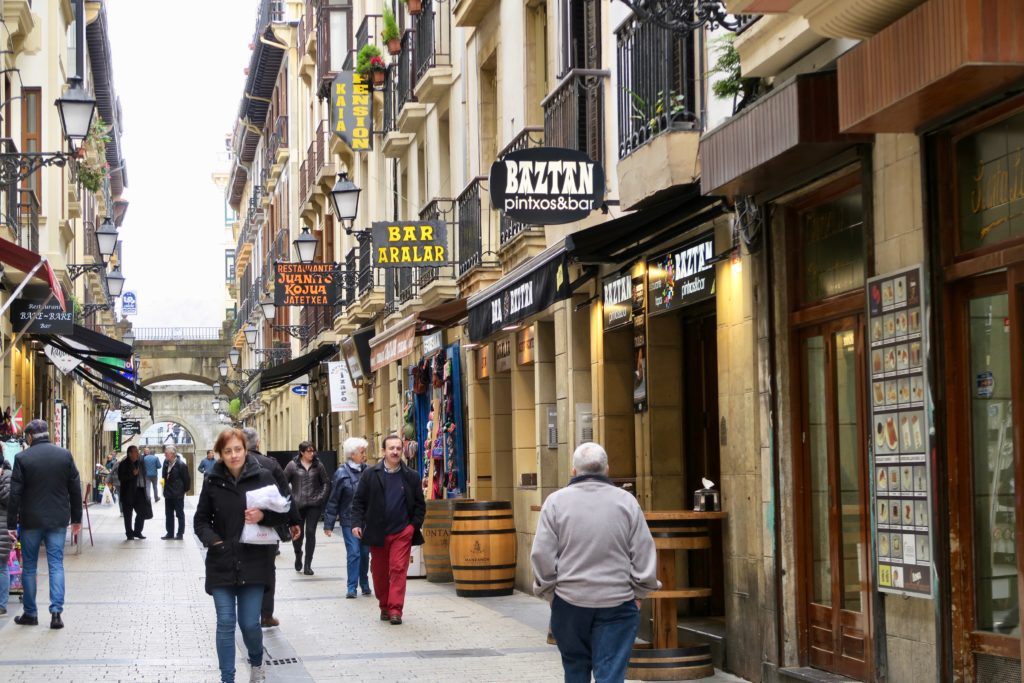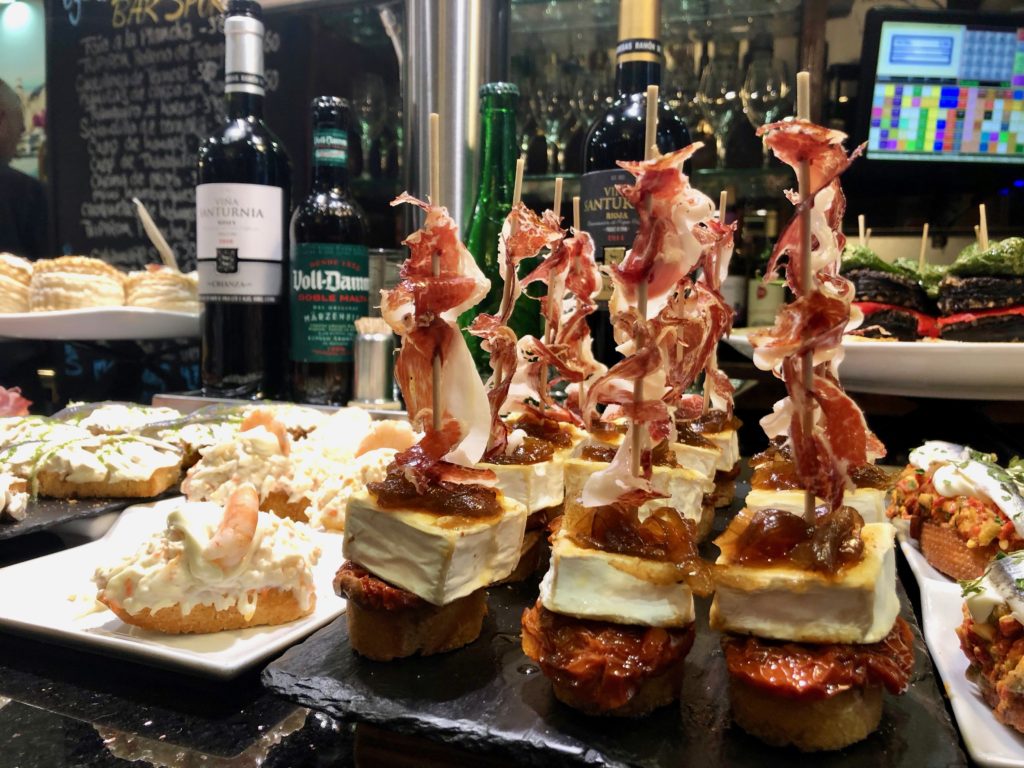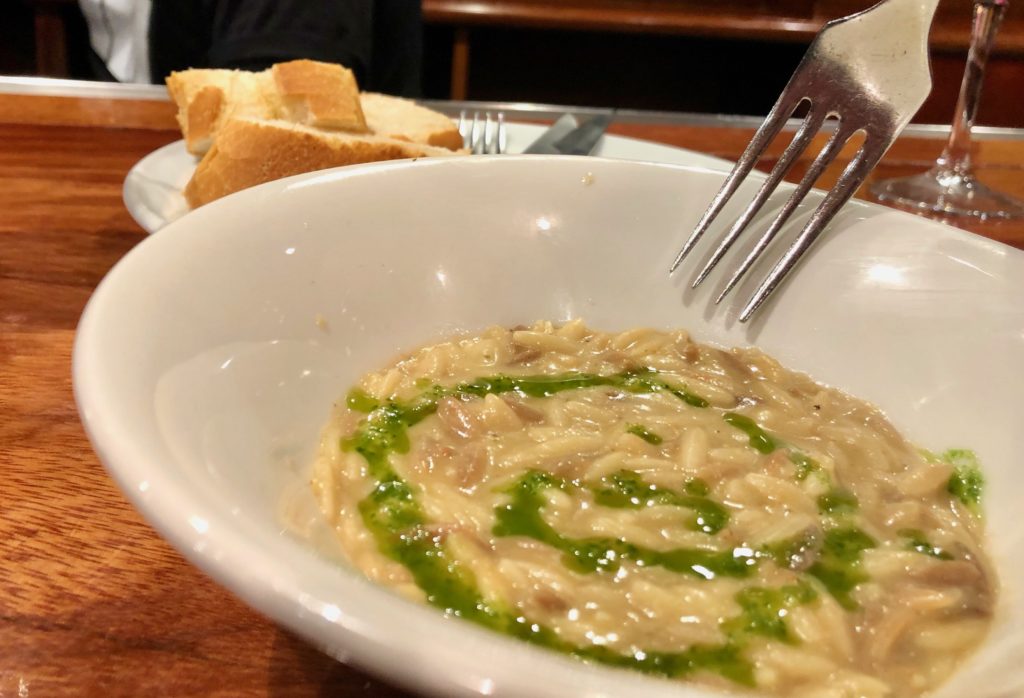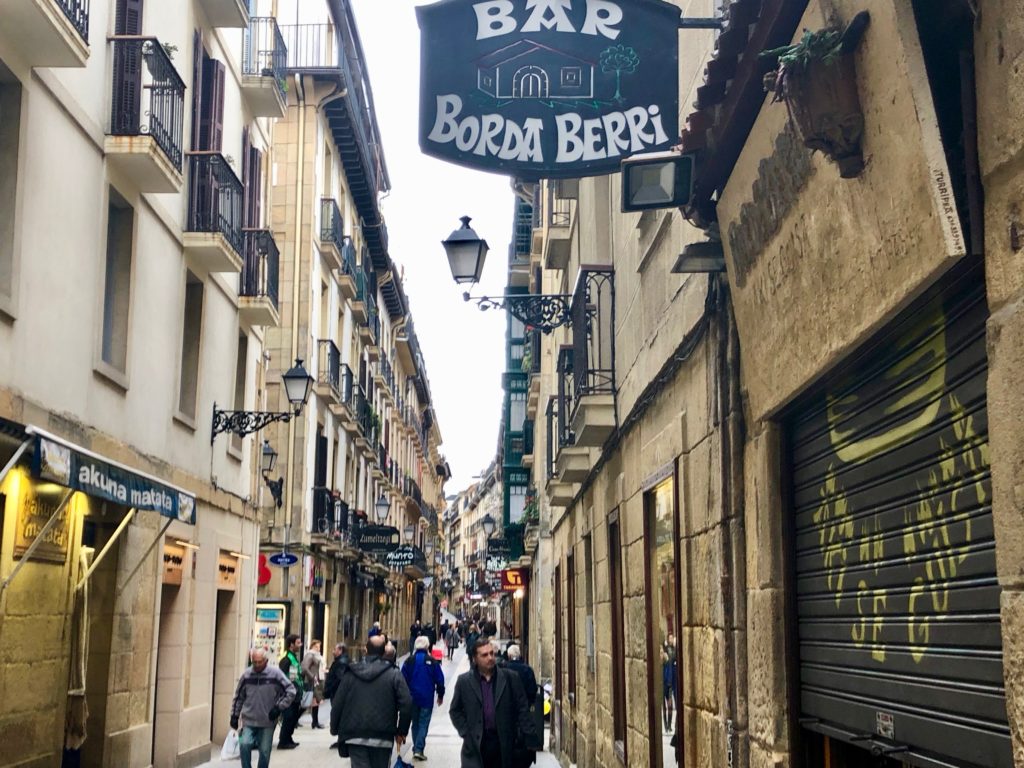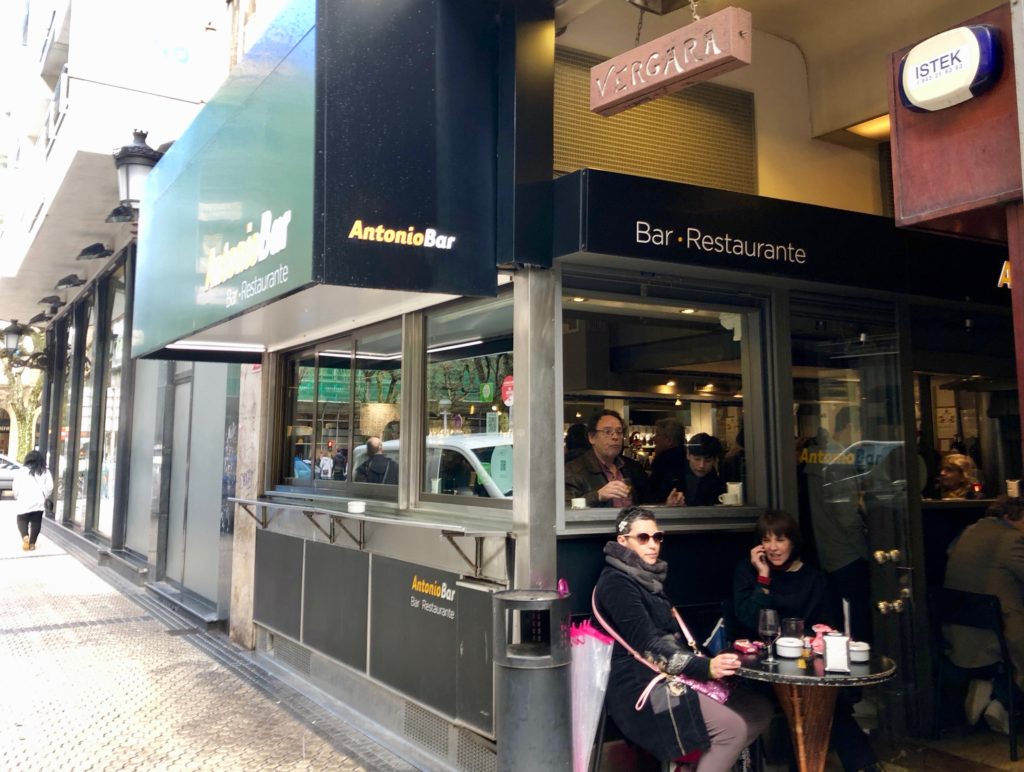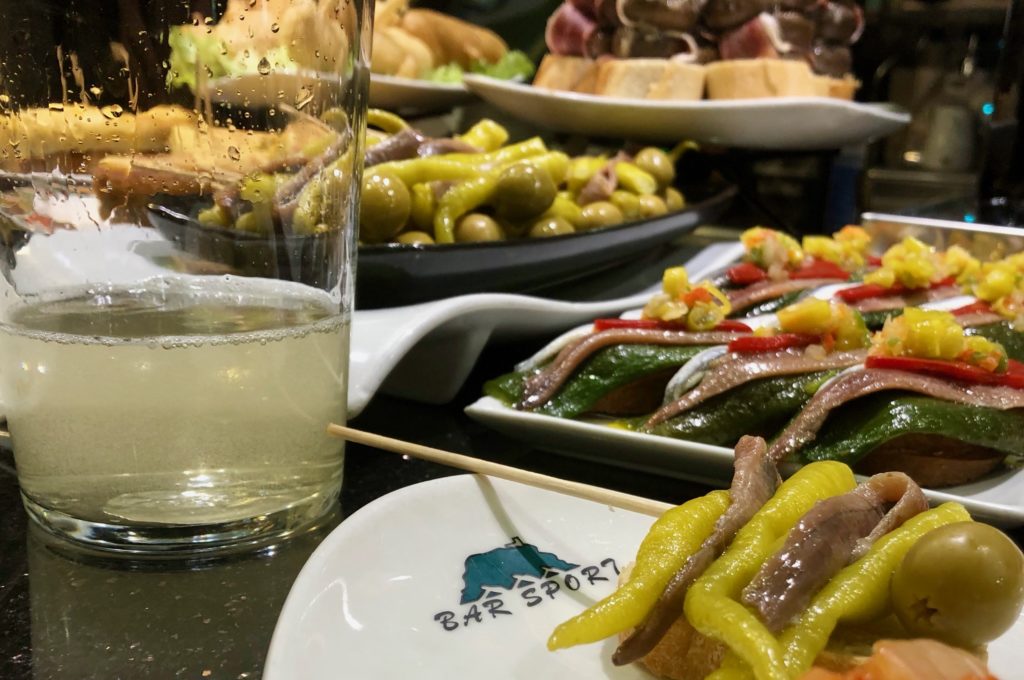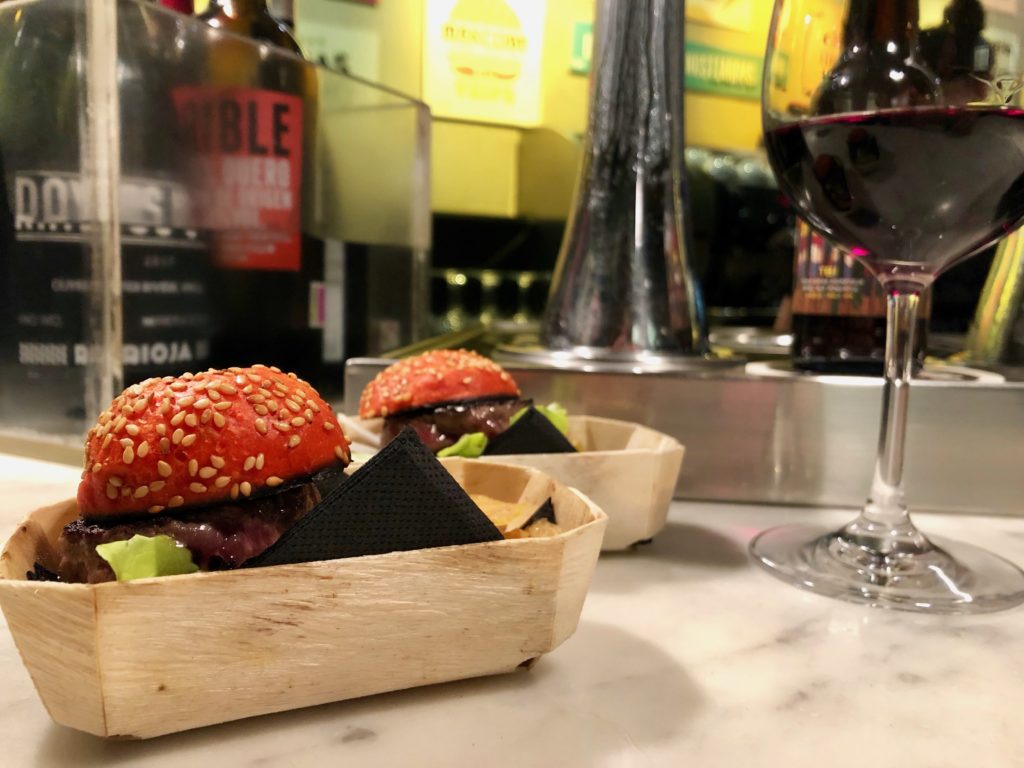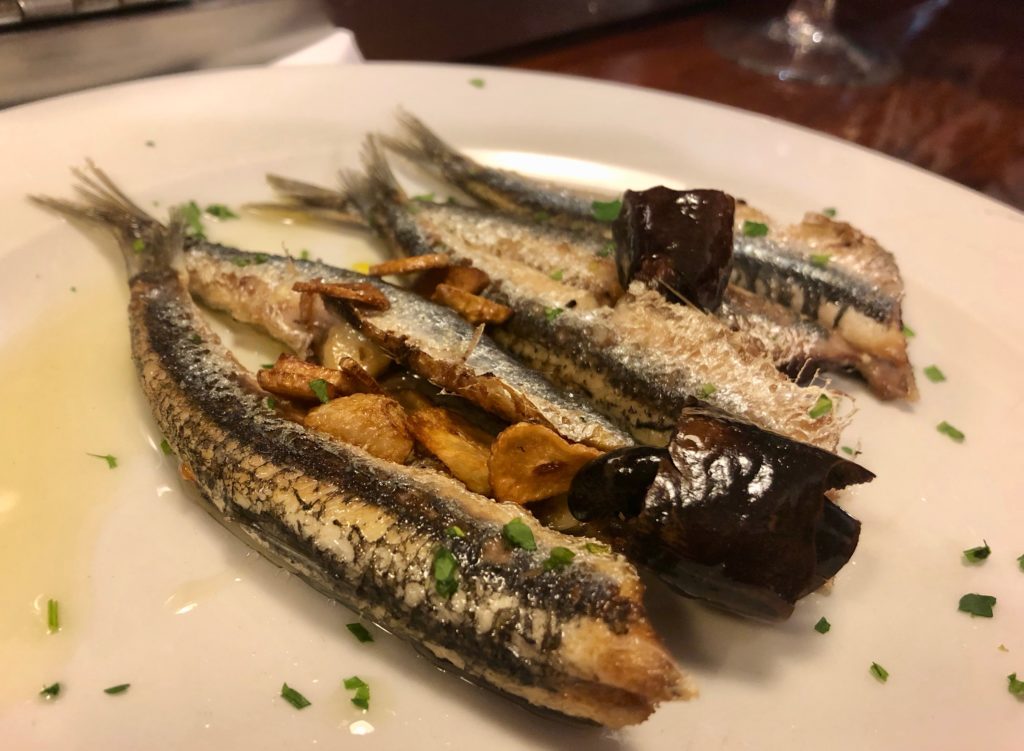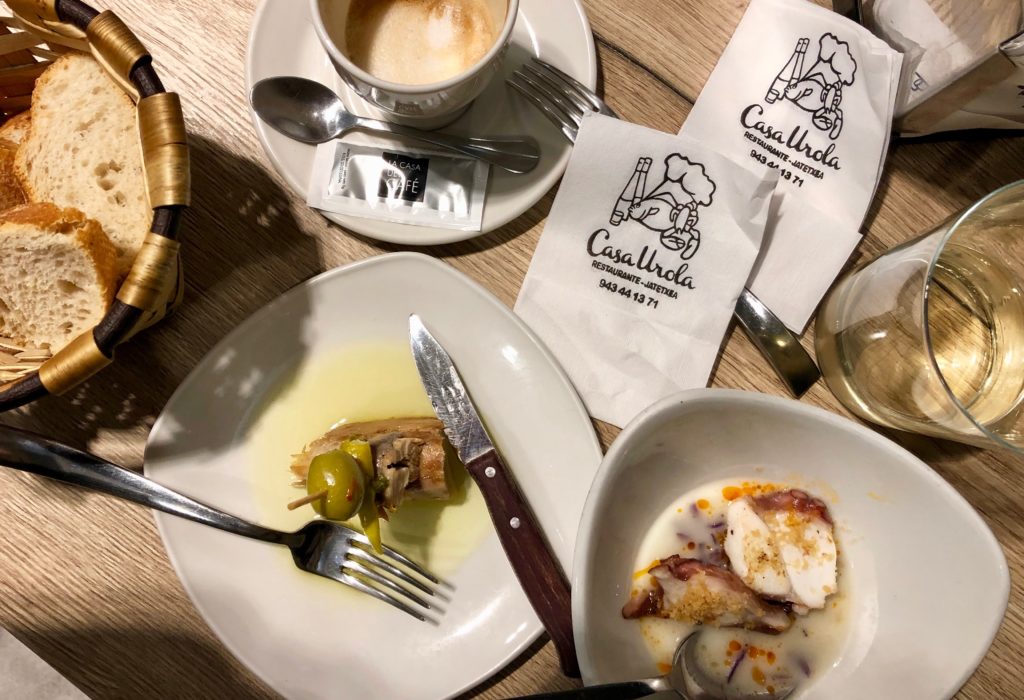Cured Iberian ham, seared foie gras, and Cantabrian anchovies pinned to a chunk of crusty white bread are but a sampling of the food you’ll encounter in San Sebastian. The city’s pintxos bars lure travelers to partake in this region’s eating and drinking tradition, one for which the gastronomic capital is known around the world.
San Sebastian gastronomy is considered the crowd puller in Spain’s Basque Country – and for good reason. A roam through Old Town (Parte Vieja) rouses the appetite as kitchen aromas waft through the web of cobbled alleyways. Food is a serious business here. Come evening, crowds flood Old Town – the city’s pintxos bar epicenter – and continue to nibble often until midnight, when most kitchens finally close.
The Basque “pintxo” or Spanish “pincho” is derived from Pinchar, which means to pierce. The skewers or toothpicks holding each ingredient neatly onto that mouthful of bread signify pincho. In San Sebastian, grazing on pintxos is as routine as shops shutting their doors for afternoon siesta. Donastiarras (the locals) likely wash down the delicious skewered tapas with a pour of Txakoli (a locally-produced effervescent white wine), Tempranillo, or zurito (small glass of beer), since drinking is also quintessential to Basque culture.
Menus often feature the same or similar pintxos, sometimes with a bar’s unique twist. Some bars present Michelin Star-worthy creations while others stick to the straightforward-yet-tasty, like the “Gilda” – supposedly the first-ever pintxo inspired by the film noir of the same name starring Rita Hayworth – consisting of a pickled guindilla pepper, a salty anchovy, and a green olive. This pintxo is an excellent intro to the feast that lies ahead.
Cold pintxos are the most popular, many made with seafood (tuna, skate, sardines, anchovies, octopus), others with meat (pork, lamb, beef, duck) while a handful of vegetarian options round out the choices. But don’t miss the chance to eat hot pintxos, frequently made to order. Pintxos like risotto can’t be bound with a pick or skewer, but they’re almost always accompanied by a slice or basket of crusty white baguette.
The Basics of Eating Pintxos
How to eat pintxos varies by the bar. Some bartenders hand over a plate while others expect guests to point and nod, signaling which pintxos they have their eye on. Don’t worry about the language barrier (Basque is the official language but Spanish is widely spoken) because an enthusiastic “Hola!” and a smile go a long way. If you notice crumpled paper napkins on the bar’s floor, then go ahead and toss yours when finished. Discarding used towels onto the floor is acceptable in some bars but unpopular in others, so follow the locals.
Generally, pintxos are an enticing prelude to a meal, or, more commonly, locals devour a hearty several-course lunch in the afternoon, and then eat a medley of pintxos around 9 or 10 pm. Hence, a bevy of bars reopens at 8 pm after the mid-day break (siesta).
As tempting as the petite but beautiful stacks of food are (it’s tough to eat a single), the culture of eating pintxos is to select one or two at each spot and move on while still peckish, hopefully working up an appetite as the eating fest progresses. Sure, parking oneself at a favorite pintxos bar for several hours is possible, but that would be a disservice to the culinary tradition in this part of the world. Bar-hopping or pintxos crawling is the lifeblood of San Sebastian’s food scene.
A pintxos crawl may sound like an expensive proposition, but it’s quite the opposite. Pintxos range from two to five Euros each, generally, and wine, though the pours are small, will cost another two to four Euros per glass. “Raciones” – rations or larger plates – are also available and can range from six to 20 Euro and higher depending on the venue. And for those who prefer a sit-down dining experience, some bars offer a full-service restaurant in a separate section.
While discovering a labyrinth of pintxos outposts in Old Town is inevitable, you’ll run into several excellent options outside the touristic center as well. No matter your preference, go hungry and thirsty, savoring every bite.
Must-Visit Pintxos Bars
“Go where the locals go” is a steadfast piece of advice when traveling. Therefore, no one can go wrong at Antonio Bar (Bergara Kalea, 3), where a stream of Basque patrons flow in and out well before lunchtime (the bar opens at 7:30 am). For breakfast, the Spanish tortilla (similar to an omelet) – eggs chock full of caramelized onions and potatoes – could be the best dish of the day. The langoustine ravioli and foie gras are also worth trying at this cozy spot near Plaza Gipuzkoa.
If duck breast brochette and shrimps with bechamel sound appealing, dedicate some time to Gandarias (31 de Agosto Kalea, 23), one of the town’s most traditional pintxos bars. Unlike some of its neighbors, Gandarias doesn’t close in the afternoon, so expect a smorgasbord of freshly made, colorful pintxos such as peppers stuffed with crab and mushrooms with ham and lemon. Take note of the hot (caliente) pintxos listed on the wall.
Situated in the heart of Old Town, Bar Sport (Fermin Calbeton Kalea, 10) plates pintxos almost too pretty to eat. Friendly and accommodating bartenders like to show off, pouring fizzy txakoli at least three feet away from the tumbler resting on the bar. Don’t get distracted, because it’s all about the food, and the spread at Bar Sport is one of the most impressive you’ll see. Must-tries include the crepes, foie gras, and cheesecake. For adventurous eaters, sea urchin is also on the menu.
Cross the Santa Catalina Bridge to the hip Gros neighborhood for a sampling of San Sebastian life like a local. In business since 1928, Bodega Donostiarra (Peña y Goñi Kalea, 13) is one of the city’s go-to pintxos bars and a venerable choice among Basque natives. Finding a foot or two at the bar is a challenge, but eventually, the most patient will squeeze in, as a table can be even tougher to come by. Nonetheless, the crowd and lack of elbow room won’t influence the intense flavor of the pulled beef with tomato sauce or the Instagram-worthy octopus and shrimp hanging from a metal skewer.
For avant-garde pintxos, try the award-winning A Fuego Negro (31 de Agosto Kalea, 31). The food here is daring and unexpected, straying from the traditional and a step above many others in town. Opened in 2006, A Fuego Negro has become one of the most chatted-about pintxos bars in San Sebastian. The Kobe beef sliders perched on a bright tomato bun and the Rabas – black squid ink miniature doughnuts creatively presented on a fork handle – are two of the bar’s signature (and most appetizing) dishes.
The well-known Borda Berri (Fermin Calbeton Kalea, 12) stays busy, so be prepared to wait as a flurry of guests arrive early, even before it opens. Do the same to get to the front of the queue and know what to order once you reach the bar. Pork rib, black ink ravioli and grilled hake are menu highlights, as are the veal cheeks with red wine sauce, supposedly the most tender in San Sebastian.
Around since 1948 and now owned by the Pollos family, La Cepa (31 de Agosto Kalea, 7, 9) cooks classic Basque cuisine, packing in regulars and attracting tourists too. Unlike some other pintxos bars with odd hours, La Cepa is open all day, six days a week (closed only on Tuesdays). Start with the flawlessly grilled sardines drizzled with extra- virgin olive oil followed by a salt-sprinkled sirloin skewer, cooked medium-rare and served with green peppers and potato chips (fries). Perfection.
Relish the inventive pintxos at Bar Bergara (Calle del General Artetxe, 8), also in the Gros district across the river from Old Town. Seafood delicacies such as the Chupita de Changurro or shot of crab garnished with shrimp, the Udaberri or zucchini with cream of crayfish, and the Txalupa or gratinate of mushrooms with king prawns are obvious, mouthwatering picks. Besides its prize-winning food, Bergara sports a bright white modern interior, making for a pleasant pintxos-eating experience.
A narrow bar next to the San Telmo Museum, La Cuchara de San Telmo (Santa Korda Kalea, 4) is regularly rated one of San Sebastian’s best pintxos bars. At this uber-casual spot, the kitchen prepares Basque classics but with a modern twist. Dishes come listed on a blackboard menu behind the standing room bar, which stays rammed with foodies enjoying the tender octopus, decadent foie gras and creamy risotto Idiazabal.
For a landmark restaurant serving some of the city’s tastiest pintxos, try Casa Urola Jatetxea (Fermin Calbeton Kalea, 20). Opened in 1956, the restaurant is located on the upper floor while pintxos rotate downstairs. Ham and cheese croquettes, lobster topped with salmon roe, and beef cheeks are frontrunners, but you can’t go wrong with most any item on the menu. Friendly and English-speaking staff paired with excellent pintxos encourage lingering in Casa Urola, so this one may be your final stop.
